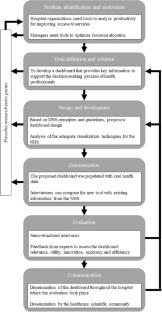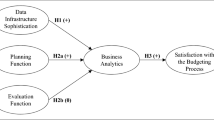Abstract
Health information systems have been developed to help hospital managers steer daily operations, including key performance indicators (KPIs) for monitoring on a time-aggregated basis. Yet, current literature lacks in proposals of productivity dashboards to assist hospitals stakeholders. This research focuses on two related problems: (1) hospital organizations need access to productivity information to improve access to services; and (2) managers need productivity information to optimize resource allocation. This research consists in the development of dashboards to monitor information obtained from a hospital organization to support decision makers. To develop and evaluate the productivity dashboard, the Design Science Research (DSR) methodology was adopted. The dashboard was evaluated by stakeholders of a large Portuguese hospital who contributed to iteratively improving its design toward a useful decision support tool. Additionally, it was ascertained that monitoring productivity needs more study and that the dashboards on these themes are valuable assets at a monitoring level and subsequent decision-making process.

















Similar content being viewed by others
References
Rahimi, H., Kavosi, Z., Shojaei, P., and Kharazmi, E., Key performance indicators in hospital based on balanced scorecard model. J. Heal. Manag. Informatics 4(1):17–24, 2016.
McDermott, C., and Stock, G. N., Hospital operations and length of stay performance. Int. J. Oper. Prod. Manag. 27(9):1020–1042, 2007.
Koumpouros, Y., Balanced scorecard: Application in the general Panarcadian Hospital of Tripolis, Greece. Int. J. Health Care Qual. Assur. 26(4):286–307, 2013.
Poba-Nzaou, P., Uwizeyemungu, S., Raymond, L., and Paré, G., Motivations underlying the adoption of ERP systems in healthcare organizations: Insights from online stories. Inf. Syst. Front. 16(4):591–605, 2014.
Sun, J., and Qu, Z., Understanding health information technology adoption: A synthesis of literature from an activity perspective. Inf. Syst. Front. 17(5):1177–1190, 2015.
Moro, S., Cortez, P., and Rita, P., Business intelligence in banking: A literature analysis from 2002 to 2013 using text mining and latent Dirichlet allocation. Expert Syst. Appl. 42(3):1314–1324, 2015.
Ghazisaeidi, M., Safdari, R., Torabi, M., Mirzaee, M., Farzi, J., and Goodini, A., Development of performance dashboards in healthcare sector: Key practical issues. Acta Inform. Medica 23(5):317–321, 2015.
T. Knabke and S. Olbrich, “The impact of in-memory technology on the agility of data warehouse-based business intelligence systems - a preliminary study among experts,” Proc. der 12. Int. Tagung Wirtschaftsinformatik (WI 2015), no. Paper 44, pp. 645–659, 2015.
Forsman, J., Anani, N., Eghdam, A., Falkenhav, M., and Koch, S., Integrated information visualization to support decision making for use of antibiotics in intensive care: Design and usability evaluation. Informatics Heal. Soc. Care 38(4):330–353, 2013.
Baskett, L., LeRouge, C., and Tremblay, M. C., Using the dashboard technology properly. Health Prog. 89(5):16–23, 2008.
J. Ryan, B. Doster, S. Daily, and C. Lewis, “Key Performance Indicators across the Perioperative Process: Holistic Opportunities for Improvement via Business Process Management,” pp. 3479–3488, 2017.
Eckerson, W. W., Performance dashboards: Measuring, monitoring, and managing your business. John Wiley & Sons, 2010.
Pauwels, K. et al., Dashboards as a service: Why, what, how, and what research is needed? J. Serv. Res. 12(2):175–189, 2009.
Berler, A., Pavlopoulos, S., and Koutsouris, D., Using key performance indicators as knowledge-management tools at a regional health-care authority level. IEEE Trans. Inf. Technol. Biomed. 9(2):184–192, 2005.
M. Linna, “Benchmarking hospital productivity,” no. 7, pp. 1–5, 2006.
Nguyen, B. V., Burstein, F., and Fisher, J., Improving service of online health information provision: A case of usage-driven design for health information portals. Inf. Syst. Front. 17(3):493–511, Jun. 2015.
Black, N., Browne, J., and Cairns, J., Health care productivity. BMJ 333(7563):312–313, Aug. 2006.
A. Sharpe, H. Messinger, and C. Bradley, “The measurement of output and productivity in the health care sector in Canada: An overview,” 2007.
Henkel, M., Johannesson, P., and Perjons, E., Value and goal modelling in healthcare. Management:1–14, 2007.
Ashrafi, N., Kelleher, L., and Kuilboer, J.-P., The impact of business intelligence on healthcare delivery in the USA. Interdiscip. J. Inf. 9(9):117–130, 2014.
Kawamura, T., Kimura, T., and Tsumoto, S., Estimation of service quality of a hospital information system using a service log. Rev. Socionetwork Strateg. 8(2):53–68, 2014.
Mettler, T., and Vimarlund, V., Understanding business intelligence in the context of healthcare. Health Informatics J. 15(3):254–264, 2009.
Stadler, J. G., Donlon, K., Siewert, J. D., Franken, T., and Lewis, N. E., Improving the efficiency and ease of healthcare analysis through use of data visualization dashboards. Big Data 4(2):129–135, 2016.
S. Al-Hajj, I. Pike, and B. Fisher, “Interactive Dashboards: Using Visual Analytics for knowledge Transfer and Decision Support,” 2013 Work. Vis. Anal. Healthc., pp. 37–40, 2013.
H. Providers and G. S. Nelson, “The Healthcare Performance Dashboard : Linking Strategy to Metrics Table of Contents SAS Global Forum 2010,” pp. 1–10, 2010.
Park, K. W., Smaltz, D., McFadden, D., and Souba, W., The operating room dashboard. J. Surg. Res. 164(2):294–300, 2010.
Prevedello, L. M., Andriole, K. P., Hanson, R., Kelly, P., and Khorasani, R., Business intelligence tools for radiology: Creating a prototype model using open-source tools. J. Digit. Imaging 23(2):133–141, 2010.
E. R. Mahendrawathi, D. Pranantha, and J. D. Utomo, “Development of dashboard for hospital logistics management,” ICOS 2010–2010 IEEE Conf. Open Syst., no. Icos, pp. 86–90, 2010.
Martin, N., Bergs, J., Eerdekens, D., Depaire, B., and Verelst, S., Developing an emergency department crowding dashboard: A design science approach. Int. Emerg Nurs 39:68–76, 2018.
Ward, M. J., Marsolo, K. A., and Froehle, C. M., Applications of business analytics in healthcare. Bus. Horiz. 57(5):571–582, 2014.
Gordon, J., and Richardson, E., Continuous improvement in the Management of Hospital Wards: The use of operational dashboards. Int. J. Manag. 30(4):414–417, 2013.
R. Shailam, A. Botwin, M. Stout, and M. S. Gee, “Real-time electronic dashboard technology and its use to improve pediatric radiology workflow,” Curr Probl. Diagnostic Radiol., 2017.
S. Al-Hajj, I. Pike, B. E. Riecke, and B. Fisher, “Visual analytics for public health: Supporting knowledge construction and decision-making,” Proc. Annu. Hawaii Int. Conf. Syst. Sci., 2013.
Franklin, A., Gantela, S., Shifarraw, S., Johnson, T. R., Robinson, D. J., King, B. R., Mehta, A. M., Maddow, C. L., Hoot, N. R., Nguyen, V., Rubio, A., Zhang, J., and Okafor, N. G., Dashboard visualizations: Supporting real-time throughput decision-making. J. Biomed. Inform. 71:211–221, 2017.
Hill, H. M., Measuring productivity in bioanalysis. Bioanalysis 4(19):2317–2319, 2012.
Zhang, X., Gallagher, K., and Goh, S., BI application: Dashboards for healthcare. 17th Am. Conf. Inf. Syst. 2011, AMCIS 2011 5:3898–3902, 2011.
Hain, P. D., Daru, J., Robbins, E., Bode, R., Brands, C., Garber, M., Gosdin, C., Marks, M., Percelay, J., Terferi, S., and Tobey, D., A proposed dashboard for pediatric hospital medicine groups. Hosp. Pediatr. 2(2):59–68, 2012.
M. Barrento, “Admissão da Business Intelligence às Urgências Hospitalares Business Intelligence admission to Hospital emergency,” 2013.
W. Presthus and I. Bergum, “Business Intelligence to the People. A Case Study of Dashboard Adoption in the Health Care sector,” Nor. Konf. Organ. bruk av IT, vol. 23, no. 1, 2015.
Daley, K., Richardson, J., James, I., Chambers, A., and Corbett, D., Clinical dashboard: Use in older adult mental health wards. Psychiatrist 37(3):85–88, 2013.
Donaldson, N., Brown, D. S., Aydin, C. E., Bolton, M. L. B., and Rutledge, D. N., Leveraging nurse-related dashboard benchmarks to expedite performance improvement and document excellence. J. Nurs. Adm. 35(4):163–172, 2005.
Miniati, R., Frosini, F., Cecconi, G., Dori, F., Iadanza, E., Biffi Gentili, G., Belardinelli A, “Development of Web-Based Operating Theatre Dashboard for Activity Monitoring and Planning in Hospitals,” Proc. IEEE-EMBS Int. Conf. Biomed. Heal. Informatics (BHI 2014), vol. 50139, p. IN PRESS, 2014.
McLeod, B., Zaver, F., Avery, C., Martin, D. P., Wang, D., Jessen, K., and Lang, E. S., Matching capacity to demand: A regional dashboard reduces ambulance avoidance and improves accessibility of receiving hospitals. Acad. Emerg. Med. 17(12):1383–1389, 2010.
J. P. McGlothlin, S. Vedire, E. Crawford, J. Pappas, B. Bruneau, and L. Obregon, “Improving patient care through analytics,” 2016 4th Int. Symp. Comput. Bus. Intell., pp. 94–100, 2016.
Ryan, J., Doster, B., Daily, S., and Lewis, C., A balanced perspective to perioperative process management aligned to hospital strategy. Int. J Heal. Inf Syst. Informatics 9(4):1–19, 2014.
S. Al-Hajj, I. Pike, and B. Fisher, “Visual analytics to support medical decision-making process,” XXIV Conf. Eur. Fed. Med. Inf. Qual. life through Qual. Information., pp. 1–3, 2012.
L. A. Mallak, “DPM and DFID: Interactive tools for evidence-based decision making,” PICMET Portl. Int. Cent. Manag. Eng. Technol. Proc., pp. 642–649, 2009.
Arinze, B., A model for delivering smart healthcare using patient-facing dashboards, clinical DSS and electronic health records. Can. Conf. Electr. Comput. Eng.:1–4, 2014.
Mattingly, W. A. et al., Real-time enrollment dashboard for multisite clinical trials. Contemp. Clin. Trials Commun. 1:17–21, 2015.
Egan, M., Clinical dashboards. Crit. Care Nurs. Q. 29(4):354–361, 2006.
Jha, A., and Epstein, A., Hospital governance and the quality of care. Health Aff. 29(1):182–187, 2010.
Perron, C. E., Bachur, R. G., and Stack, A. M., Development, implementation, and use of an emergency physician performance dashboard. Clin. Pediatr. Emerg. Med. 18(2):115–123, 2017.
Dixon, B. E., Jabour, A. M., Phillips, E. O. K., and Marrero, D. G., An informatics approach to medication adherence assessment and improvement using clinical, billing, and patient-entered data. J. Am. Med. Informatics Assoc. 21(3):517–521, 2014.
A. Koronios and J. Gao, “Data Quality for Emergency Department BI Dashboard,” Adv. Intell. Syst. Res., no. 2001, pp. 301–309, 2010.
P. Silva et al., “Hospital database workload and fault forecasting,” 2012 IEEE-EMBS Conf. Biomed. Eng. Sci. IECBES 2012, no. December, pp. 63–68, 2012.
R. Alharbey, “Predictive Analytics Dashboard for Monitoring Patients in Advanced Stages of COPD,” 2016 49th Hawaii Int. Conf. Syst. Sci., pp. 3455–3461, 2016.
M. Y. Santos, “A data-driven analytics approach in the study of pneumonia ’ s fatalities,” 2015.
J. Ryan, B. Doster, S. Daily, and C. Lewis, “Key performance indicators across the perioperative process: Holistic opportunities for improvement via business process management,” in Proceedings of the 50th Hawaii international conference on system sciences, 2017.
M. Barrento, “European Benchmarking in Healthcare Analysis by Country with highlight on Portugal,” pp. 1–4, 2017.
V. Georgiana, D. Kartawiguna, and Indrajani, “Evaluation of radiology data warehouse implementation on education, research, and quality assurance,” Proc. 2016 Int. Conf. Inf. Manag. Technol. ICIMTech 2016, no. November, pp. 277–280, 2017.
Hevner, A. R., March, S. T., Park, J., and Ram, S., Design science in information systems research. MIS Q. 28(1):75–105, 2004.
S. Few, “Information dashboard design,” 2006.
C. N. Knaflic, Storytelling with data: A data visualization guide for business professionals. John Wiley & Sons, 2015.
Nogueira, Paulo; Martins, José; Rita, Francisco; Fatela L., “Dashboards da saúde: passado, presente e futuro. Uma Perspetiva Da Evolução Em Portugal.,” pp. 1–9, 2017.
Karami, M., Langarizadeh, M., and Fatehi, M., Evaluation of effective dashboards: Key concepts and criteria. Open Med Inform J 11(1):52–57, 2017.
C. A. Wexler, Steve, Shaffer Jeffrey, The big book of dashboards: visualizing your data using real-world business scenarios. Wiley, 2017.
Voelker, K. E., Rakich, J. S., and French, G. R., The balanced scorecard in healthcare organizations: A performance measurement and strategic planning methodology. Hosp. Top. 79(3):13–24, 2001.
Author information
Authors and Affiliations
Corresponding author
Ethics declarations
Conflict of interest
The authors declare that they do not have conflicts of interest.
Ethical approval
This article does not contain any studies with human participants or animals performed by any of the authors.
Additional information
Publisher’s Note
Springer Nature remains neutral with regard to jurisdictional claims in published maps and institutional affiliations.
This article is part of the Topical Collection on Systems-Level Quality Improvement
Rights and permissions
About this article
Cite this article
Pestana, M., Pereira, R. & Moro, S. Improving Health Care Management in Hospitals Through a Productivity Dashboard. J Med Syst 44, 87 (2020). https://doi.org/10.1007/s10916-020-01546-1
Received:
Accepted:
Published:
DOI: https://doi.org/10.1007/s10916-020-01546-1




